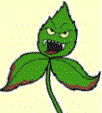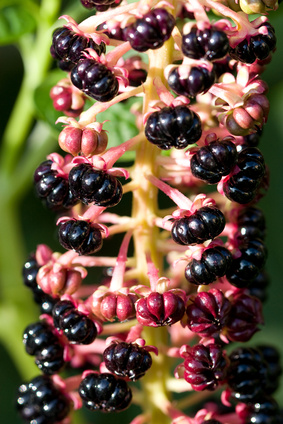Phytolacca decandra (L)

Synonyms: Phytolacca americana (L.), coakum, pigeonberry, poke, red plant, pocan, pokeweed, inkberry, red weed, scoke, American nightshade, garget, bear's grape, crowberry, red-ink plant, jalap, cancer root, chongras, herbe de la laque
Order: Phytolaccaceae
 Description: Phytolacca is a perennial which
can reach a height of 4m, though more usually 1.5-2m. It has vigorous green or purple stems
which bear
alternate simple leaves and numerous small white or pale green flowers in
drooping racemes that give way to clusters of red-staining purple berries. The
large fleshy root is externally banded with bars of cork and is pale yellow-brown in
colour, internally paler, and with zones of fibrous elements making it hard to
break. It grows in damp soils and shady places in eastern North America and is
naturalised in southern Europe.
Description: Phytolacca is a perennial which
can reach a height of 4m, though more usually 1.5-2m. It has vigorous green or purple stems
which bear
alternate simple leaves and numerous small white or pale green flowers in
drooping racemes that give way to clusters of red-staining purple berries. The
large fleshy root is externally banded with bars of cork and is pale yellow-brown in
colour, internally paler, and with zones of fibrous elements making it hard to
break. It grows in damp soils and shady places in eastern North America and is
naturalised in southern Europe.
Parts used: the root
Collection: The root should is unearthed in late autumn or spring.
Constituents: triterpenoid saponins (phytolaccasides), alkaloid (phytolaccine), resins, phytolaccic acid, tannin, formic acid, sugars, proteins
Actions: antirheumatic, mild anodyne, cathartic, stimulant, anticatarrhal, purgative and emetic in large doses, parasiticide, fungicide, anti-inflammatory, possibly stimulates leucocyte and lymphatic activity
Indications: chronic rheumatism, chronic respiratory catarrh, tonsillitis, laryngitis, adenitis, mastitis, mumps. Externally as an ointment for scabies, tinea, acne; as a poultice for mastitis and mammary abscess
Therapeutics and Pharmacology: Phytolacca a remedy used in the treatment of inflammatory conditions of the upper respiratory tract and lymphatic adenitis, removing catarrh and aiding the cleansing of the lymphatic glands. It may be used for catarrh, tonsillitis, laryngitis, swollen glands, mastitis, mumps, etc. It is of value in lymphatic problems elsewhere in the body, particularly mastitis, where it can be used internally and as a poultice. It also has a use in rheumatism, particularly where it is long-standing. Externally, as a lotion or ointment, it may be used to rid the skin of scabies and other pests, tinea, and acne, and it may be applied in a poultice to soothe ulcers, haemorrhoids and inflamed joints. The proteins have been shown to inhibit the replication of the influenza and HSV-1 viruses and poliovirus.
Combinations: For lymphatic problems, Phytolacca may be combined with Iris or Galium; with Guaiacum and Zanthoxylum in rheumatic conditions; or with Commiphora resin and Echinacea in tonsillitis.
Caution: The fresh plant is poisonous, and in large doses the dried root is an irritant and emetic and cathartic; there are also concerns for its wider safety. It should be used only as prescribed by a qualified practitioner, and the recommended dosages should never be exceeded. The seeds in the berries are poisonous and have caused fatalities in children. It may cause foetal abnormalities, so should not be used during pregnancy.
Preparation and Dosage: (thrice daily)
Regulatory Status: GSL Schedule 3
Dried root: 0.06-0.3g or by decoction
Liquid Extract: 1:1 in 45% alcohol, 0.1-0.5ml
Tincture: 1:10 in 45% alcohol, 0.2-0.6ml
Additional Comments: Called Pocon by the Native Americans, poke root was used as an emetic and externally for skin diseases. The Delaware people took it as a heart stimulant and in Virginia it was regarded as a strong purgative. The early American settlers used it to treat venereal disease. Even today Appalachian backwoodsmen chew the seeds and berries for arthritis - all the more remarkable because the fresh plant is extremely toxic. It arrived in Europe in the 19th century.
Bibliography
BHMA 1983 British Herbal Pharmacopoeia, BHMA, Bournemouth.
Grieve, M. 1931 A Modern Herbal, (ed. C.F. Leyel 1985), London.
Hoffmann, D. 1990 The New Holistic Herbal, Second Edition, Element, Shaftesbury.
Lust, J. 1990 The Herb Book, Bantam, London.
Mabey, R. (ed.) 1991 The Complete New Herbal, Penguin, London.
Mills, S.Y. 1993 The A-Z of Modern Herbalism, Diamond Books, London.
Ody, P. 1993 The Herb Society's Complete Medicinal Herbal, Dorling Kindersley, London.
Polunin, M. and Robbins, C. 1992 The Natural Pharmacy, Dorling Kindersley, London.
Wren, R.C. 1988 Potter's New Cyclopaedia of Botanical Drugs and Preparations, C.W.Daniel, Saffron Walden.










